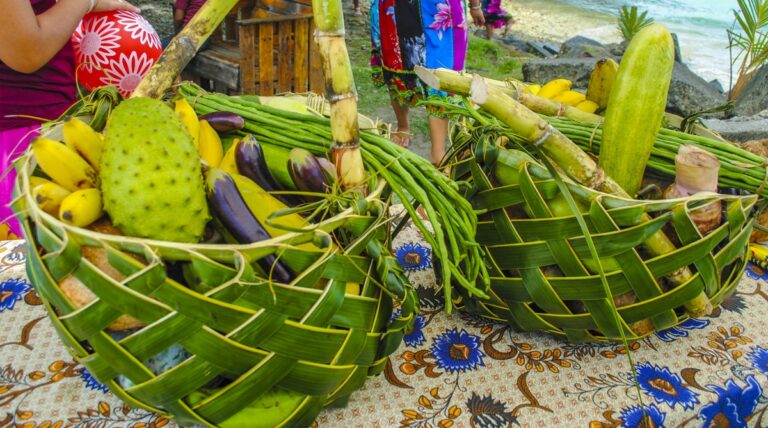Introduction: Micronesian cuisine and mealtime traditions
Micronesia is a region in the western Pacific Ocean made up of numerous small islands. Its food culture is a combination of indigenous, Southeast Asian, and European influences. Rice, seafood, taro, and yams are staple foods, while coconut milk and chili peppers are common ingredients in traditional dishes.
Mealtime in Micronesia is a social and cultural affair, where family and community members gather to share food and conversation. It is a time to strengthen bonds and show hospitality towards guests. As with many cultures, there are customs and traditions associated with eating that reflect the values and beliefs of the Micronesian people.
Traditional Micronesian meals: What do they consist of?
The most common traditional Micronesian meal is a combination of rice, fish or meat, and vegetables. The rice is usually boiled, while the fish or meat is grilled, baked, or fried. Vegetables can include taro leaves, pumpkin, yams, or sweet potatoes. Coconut milk and spices such as ginger, garlic, and chili peppers are often used to add flavor.
Another popular dish is called kelaguen, which is made from diced raw fish or meat mixed with lemon or lime juice, onions, and chili peppers. It is served cold and is often accompanied by rice and vegetables.
Eating together: The importance of communal dining
In Micronesian culture, eating together is a way to strengthen social bonds and show hospitality to guests. It is common for families to gather around a shared plate or bowl, using their hands to scoop up food. Guests are always offered the best food and are encouraged to eat as much as they want.
During mealtime, conversation is also an important ritual. It is a time to share stories, news, and jokes, and to catch up with family and friends. Elders are often given special respect and attention, and children are taught to show gratitude and good manners at the table.
Taboos and customs: What not to do at the table
Like many cultures, Micronesia has certain customs and taboos associated with eating. For example, it is considered rude to refuse food that is offered or to leave food on one’s plate. Burping and slurping are also considered impolite, as is using one’s left hand to eat or pass food.
Additionally, there are certain foods that are reserved for certain occasions or classes of people. For example, certain types of fish or meat may be reserved for chiefs or elders, while other foods may be eaten only during certain festivals or ceremonies.
Special occasions: Food and feasting in Micronesian celebrations
In Micronesian culture, food plays an important role in celebrations and ceremonies. Weddings, funerals, and other important events are marked with feasts that feature traditional foods and drinks.
One example is the Chamorro fiesta, which is a celebration of the island’s history, language, and culture. It features a large feast with traditional foods such as red rice, barbecue, and kelaguen, as well as music, dancing, and other cultural activities.
Conclusion: Micronesian dining as a reflection of culture and identity
In Micronesia, mealtime is more than just a time to eat; it is a way to connect with others and to reinforce social bonds. Traditional foods and customs reflect the values and beliefs of the Micronesian people, and are an important part of their cultural identity. Whether it is a simple family meal or a grand celebration, eating together is a cherished Micronesian tradition.

